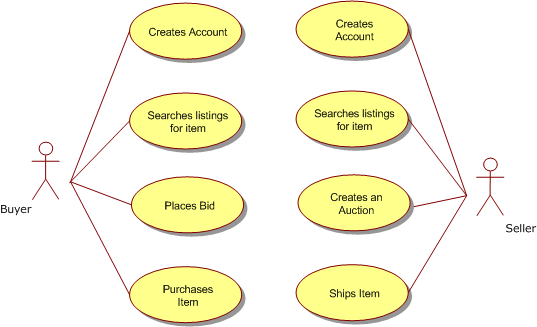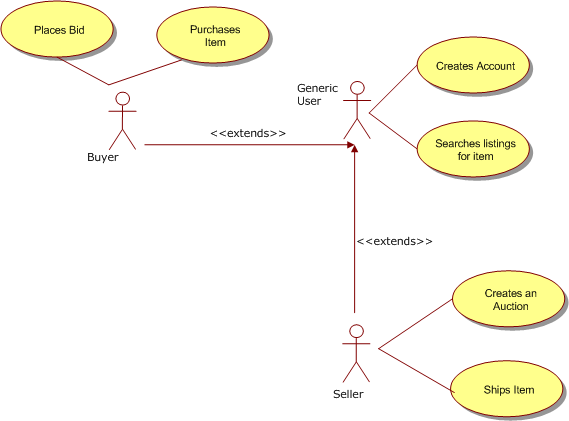Writing effective Use Case Examples
编写有效用例实例
A great way for writing effective use cases is to walk through a simple use case example and watch how it can be leveraged to something complex. By absorbing the meaning of what use case diagrams, alternate flows and basic flows, you will be able to apply use cases to your projects.
学习编写有效用例的一个很有效的方法就是通过一个小的用例实例,并观察思考怎么利用它来解决复杂的问题。通过理解吸收用例图、备选流程和主流程的含义,就可以将用例的实际应用到你的项目中。
In this section, I'm going to walk you through writing effective use cases for a mock Ebay site. Most of us know and love Ebay, so if you don't know Ebay, go to Ebay and navigate through the site and come back to our example. Imagine that only you know Ebay, but nobody has ever seen Ebay and you have to write the requirements for Ebay using use cases, and explain it to people who have never seen it.
在本节中,我将通过模拟易趣网站来学习编写有效的用例。我们大多数人所了解和喜爱易趣,所以如果你不知道易趣,前往易趣并浏览网站,再回到我们的例子。 设想,除了你知道易趣没有人见过EBay,并且要你通过使用用例写出易趣的需求,并解释给谁从未见过的人听。
STEP 1. To write effective use cases, be productive without perfection
第1步。 有效的用例,是有生产价值的、使用的,不是完美的
When it comes to writing effective use cases, you don't need to be a perfectionist and concern yourself with getting it right the first time. Developing use cases should be looked at as an iterative process where you work and refine. You can always refine it later, so again, don't go for perfection from the get-go. Loosen up and have some fun while you're doing it.
在编写用例时,你没有必要确保它的完整性甚至在第一次时也没有必要担忧它的正确性。开发用例是一个不断运行和修正的迭代的过程。您可以随时修正后,因此再次强调,不要一开始就去追求完美。 别紧张,这是一个充满乐趣的过程。
STEP 2. Define your use case actors
第2步。 定义用例的参与者
There are possibly over a dozen actors that interact with Ebay, from buyers and sellers, down to suppliers, wholesalers, auditors, and customer service. But we're going for grass-roots, so who are the basic users of Ebay? BUYERS and SELLERS. So lets put them down as our first actors. (The visual notation in the figures below is based on UML -- Unified Markup Language for Use Cases)
从买家、卖家,到供应商、批发商、审计以及客服,和易趣打交道的参与者可能有十多个。但是我们要从大众出发,谁是eBay的基本用户? 买家和卖家。 因此,把它们列为我们第一批参与者。 (下图是基于UML -统一标记语言的用例)
Do you notice how the actors aren't John and Sue which would be people? While John may be a seller and Sue may be a buyer, an actor is a Role. And a role in this case would be that of a buyer and that of a seller. Now that things are clicking, lets throw some more actors on your paper just so we can try and identify more possible users.
你是否注意到参与者不是像约翰和休这样实际的人?参与者就是一种角色扮演,如约翰可能是卖方和休可能是买家。并且在我们这个案例中,还有既是买家又是卖家的角色。现在,让我们将更多的参与者列到纸上,来帮助我们的尝试和确认更多的可能参与者。
Now we have a bunch of actors. Wait a minute? Paypal? That's not a person. An actor can be a system, because a system plays another role in the context of your new system and has goals and interacts with other actors as you will see later.
现在我们有一大堆的角色。 等一下? 贝宝公司? 这不是一个人。 一个参与者可以是一个系统,因为这个系统在您的新系统中扮演另一个角色,它有自己的任务以及与其他参与者的交互。
STEP 3. Define your use case Actor Goals
第3步。 定义您的参与者内容
Now that you have established your actors (system users), or most of them, the next logical step is to outline what the goals are of each actor. One you have established your actors and the goals of each actor, you have now created your initial list of high level use cases. In the example below you will see the representation of actor goals. Again, don't try and capture 100% of this step, in requirements management, refinement is always part of the entire process. Effective use cases should have understandable actors and goals.
现在您已经确定您的参与者(系统用户) ,或者大多数,按逻辑下一步就要列出每个参与者的内容大纲。 你已经确定参与者和每个参与者的内容,现在,你已经建立了初步的主要参与者的列表。在下面的例子中,您将看到的代表性演员内容。再次,不要图捕这一步试获100 %的参与者,在需求管理,完善修改始终贯穿于整个过程。 有效的用例应该包含明了的参与者和确定的目标任务的。
STEP 4. Identify reuse opportunity for use cases
第4步。 确定用例重用的情况
In this step, you are going to cross the bridge into object modeling. Don't get overly concerned about terms like generalization, inheritance and extends. The goal of this Ebay use case example is to keep it understandable so we will explain this concept in terms of the example.
在这个步骤中,你会了解到对象建模。 不要过分担心诸如泛化,继承和扩展。为了能更好的理解本文,我们将举例解释一下这些概念。
What does the word general mean? Something is broad and not as detailed. Generalization is when you "inherit" from something general and then add more detail. A "person" is very general. A "man" is still general, but not as general as a "person". You can say that a "man" inherits behavior and atributes of a "person".
一般这个词是什么意思?广泛的不是具体的事物。 泛化是你从一般的东西中“继承”,然后添加更多的细节。 “人”是非常普遍。 一个“男人”仍是一般,但没有 “人”更广泛 。 你可以说, “男人”是继承行为和属性的“人” 。
Look at the requirements management use case diagram above and you will see there is duplicate behavior in both the buyer and seller which includes "create an account" and "search listings". Rather than have all of this duplication, we will have a more general user that has this behavior and then the actors will "inherit" this behavior from the new user.
通过上边需求管理用例图,您将会看到买方和卖方都有重复的“创建帐户”和“搜索列表”行为。 与其都存在这个重复的部分,还不如建立一个拥有这些行为的更一般的参与者,然后其他新的参与者将“继承”这个参与者的行为。

The above use case example diagram illustrates that a generic user creates accounts and search listings and that a buyer and a seller have their own behavior but also have the behavior of the generic user. The benefits of generalization are that you eliminate duplicate behavior and attributes that will ultimately make the system more understandable and flexible. We will see in later steps that this inheritance applies both to use cases and to the actors.
上述用例图说明,建立一个一般的参与者有创建帐户和并搜索列表的行为,并且买方和卖方不但有自己的行为,还有一般参与者的行为。 泛化的好处是可以消除重复的行为和属性,使该系统更容易理解和灵活。 我们将在以后的步骤看到,这继承关系适用于用例和参与者。
STEP 5. Create a use case index
第5步。 创建一个用例索引
After producing your initial visual list of use case actors and goals, we can take this list and create an initial use case grid which provides the basis for the use case index. Every use case will have various attributes relating both to the use case iteself and to the project. At the project level, these attributes include scope, complexity, status and priority.
在产生初步的参与者及其目标的列表后,我们就可以根据这个列表,就初步建立一个包含基本用例索引的用例表单。每个用例都会包含用例之间以及用例和项目之间的各种各样的属性。在项目级属性中,包括范围,复杂性,状态和优先级。

This use case index should be used by the project team to define the use cases against. It will serve as a master inventory to help writ effective use cases for the requirements phase of the project.
这个用例索引将是整个项目成员定义用例的依据。在项目需求阶段,把它作为主要清单对能写有效的用例来说,很有帮助。
STEP 6. Identify the key components of your use case
步骤6 。 确定用例的关键部分
The actual use case is a textual representation illustrating a sequence of events. In our use case example, you will see that there are several components of a use case which we will review. In the mean time, review the table below to get a basic understanding of what is in the use case and then we will review each element as we progress through our use case example.
实际上用例是以文字形式表现的一系列事件的详细说明。在这个用例实例,你会看到,我们将继续分析那个用例包含的几个组成部分。 在此同时,通过下表对用例作基本的了解,随后我们再通过实例说明其每个元素的意思。
| Use Case Element | Description |
| Use Case Number | ID to represent your use case |
| Application | What system or application does this pertain to |
| Use Case Name | The name of your use case, keep it short and sweet |
| Use Case Description | Elaborate more on the name, in paragraph form. |
| Primary Actor | Who is the main actor that this use case represents |
| Precondition | What preconditions must be met before this use case can start |
| Trigger | What event triggers this use case |
| Basic Flow | The basic flow should be the events of the use case when everything is perfect; there are no errors, no exceptions. This is the "happy day scenario". The exceptions will be handled in the "Alternate Flows" section. |
| Alternate Flows | The most significant alternatives and exceptions |
| 用例元素 | 描述 |
| 用例编号 | 编号 |
| 应用平台 | 否涉及到什么系统或应用程序 |
| 用例名称 | 用例名称,保持言简意赅 |
| 用例描述 | 一段详细的描述 |
| 主要参与者 | 代表用例的主要参与者 |
| 先决条件 | 可以使用的先决条件 |
| 触发事件 | 什么事件触发此用例 |
| 基本流程 | 基本流程是理想状态下的事件流,没有任何错误,没有异常。 这是“快乐的日子的情况。 ” 异常情况将在 “替代流程”一节处理的。 |
| 替代流程 | 主要的替代流程和异常情况的事件流程 |
STEP 7. Name and briefly describe your use case
第7步。 用例的名称和简要说明
Now that you have a general understanding of what a use case consists of, we are ready to start creating our use case. Typically, while the name of your use case is being discussed, people will start briefly describing the use case. Use plain english and keep it simple. Getting back to our use case example, I will begin with use case #1 from step number four.
现在,你对用例的组成有了全面的了解,我们准备开始创建文明的用例了。通常情况下,大家都会从用例的简要描述开始,因为名称需要大家共同商讨。使用常见英文并保持简单。回到我们的用例#1,从第四步开始把。
| Use Case Number: | 1 |
| Use Case Name: | Buyer Places a Bid |
| Description: | An EBAY buyer has identified an item they wish to buy, so they will place a bid for an item with the intent of winning the auction and paying for the item. |
| 用例编号: | 1 |
| 用例名称: | 买家开始竞价 |
| 描述: | 易趣买家选定希望买的东西,开始竞价,并拍卖到自己想要的东西。 |
STEP 8. Create the use case basic flow
步骤8 。 创建用例基本流程
The basic flow of a use case represents the most important course of events or what happens most of the time, sometimes referred to as the 'Happy Day Scenario' because it is what occurs when everything goes well -- no errors or exceptions. Another reason why the basic flow is so critical is because it's much easier to fully comprehend the exceptions once the norm is understood and if the basic flow represents 70% of the system, the development staff is much more prone to implementing the correct code in the first pass.
基本流程代表着最重要的事件流情况或执行过程中发生在大多数情况下的情况,有时被称为'幸福的一天的场景' ,因为它所有的情况一切顺利-没有任何错误或异常。基本流程如此重要的另一个原因是在基本流程被理解和规范后,人们更容易充分理解各种异常,并且如果基本流程代表70 %的系统功能的话,开发人员更容易一次性正确的代码实现。
For our use case example, the basic flow should be to describe the happy day scenario for your use cases such as "placing a bid". For a consumer to play a successful bid, what is the primary flow when everything goes as planned. An effective use cases needs to have the basic flow before moving forward with writing the alternate flows.
在我们实例的用例中,基本流程应该是描述快乐的日子的情况,如“在出价” 。 对于消费者成功竞标,就像我们设想的一样去描述主要流程。 一个有效的用例需要在写替代流程之前有基本的流程。
STEP 9. Create the use case alternate flows
步骤9 。 建立用例替代流程
The basic flow is the key ingredient to your use case and some can argue that you can stop once you're done with the basic flow. It really depends on the level of detail you wish to achieve. However, providing more detail to the consumers of your use case is always a good thing.
基本流程是用例的主要部分,一些因素也会使你停止正常的流程。这实际取决于你想达到的详细程度。当然,给客户提供更详细的用例始终是件好事。
The alternate flows providing the following:
o An exception or error flow to any line item in your basic flow
o An additional flow, not necessarily error based, but a flow that COULD happen
A few examples of alternate flows are:
o While a customer places an order, their credit card failed
o While a customer places an order, their user session times out
o While a customer uses an ATM machine, the machine runs out of receipts and needs to warn the customer
下面是替代流程:
- 基本流程中的任意一个异常或错误
- 额外的流程,但不一定错误的,而是一个可能发生的流程
替代流程的几个例子:
- 在客户下订单时,他们的信用卡出错了
- 在客户下订单时,其用户会话超时
- 当客户使用ATM机时,机器打印出收据并需要给客户发出警告
STEP 10. Produce your effective use case document
第10步。 形成有效用例的文档
Recently at a new project assignment, I introduced a mid level developer to the concept of use cases which was totally foreign to him. Once walking him through the basic concepts and showing him the use case example, the lightbulb went off in his head on how convenient and simple it was to grasp the project.
最近在一个新的项目交接中,我一个一点都不了解用例中级的开发人员介绍这个概念。一边介绍基本的概念,一边给他看用例的实例,这样很方面和简单的让他掌握这个项目。
A few reasons why it's that much easier to learn a system through use cases then a traditional requirements document is probably because with use cases, you are introduced to concepts at a high level, walk through a living scenario and then presented with specifications last.
通过学习用例比传统的文档更易掌握一个系统有几个原因,那就你通过实际的场景和规范的文档,在较高的层次介绍一个系统。
In several places in this document, I have stated "effective use cases" rather than just "use cases". The purpose of the use cases is for effective knowledge transfer from the domain expert to the software developer -- these use cases will serve as software requirements. If they don't make sense to the person building the software, they are not effective. There are several sources on the web for writing effective use cases including the book by Alistair Cockburn.
在本文的很多地方,我强调“有效用例” ,而不是仅仅“用例” 。用例能有效的帮助我们将一个领域的专家知识转换为开发者需要的信息,也就是软件开发的需求。如果这对开发者没有产生作用的话,这些用例将是无效的。网上有不少关于阿利斯泰尔科伯恩写的有效用例这本书的资源。
STEP 11. Generate a Use Case Model Diagram
第11步。 生成一个用例模型图
You can use the Gatherspace.com use case modeling tool to produce a use case model within a few clicks. Once you define your use cases and actors, just go into the reporting section and click on the 'Use Case Model' report and that's it. From the main use case model, you can continue to drill down into the use cases.
您可以使用Gatherspace.com上的用例建模工具,方便的产生一个用例模型。一旦您确定您的用例和参与者,只需要进入报告那个步骤,并点击用例模型报告,就是这样。 从主用例模型,您可以继续深入其他用例。
To see what this looks like, click the use case model sample now..
看看他神秘的样子吧,现在就请点击用例模型例子。




















 1139
1139











 被折叠的 条评论
为什么被折叠?
被折叠的 条评论
为什么被折叠?








